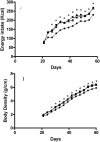Abdominal adiposity, insulin and bone quality in young male rats fed a high-fat diet containing soybean or canola oil
- PMID: 22012056
- PMCID: PMC3180158
- DOI: 10.1590/s1807-59322011001000022
Abdominal adiposity, insulin and bone quality in young male rats fed a high-fat diet containing soybean or canola oil
Abstract
Objectives: A low ratio of omega-6/omega-3 polyunsaturated fatty acids is associated with healthy bone properties. However, fatty diets can induce obesity. Our objective was to evaluate intra-abdominal adiposity, insulin, and bone growth in rats fed a high-fat diet containing low ratios of omega-6/omega-3 provided in canola oil.
Methods: After weaning, rats were grouped and fed either a control diet (7S), a high-fat diet containing soybean oil (19S) or a high-fat diet of canola oil (19C) until they were 60 days old. Differences were considered to be significant if p<0.05.
Results: After 60 days, the 19S and 19C groups showed more energy intake, body density growth and intraabdominal fat mass. However, the 19S group had a higher area (200%) and a lower number (44%) of adipocytes, while the 7S and 19C groups did not differ. The serum concentrations of glucose and insulin and the insulin resistance index were significantly increased in the 19C group (15%, 56%, and 78%, respectively) compared to the 7S group. Bone measurements of the 19S and 19C groups showed a higher femur mass (25%) and a higher lumbar vertebrae mass (11%) and length (5%). Computed tomography analysis revealed more radiodensity in the proximal femoral epiphysis and lumbar vertebrae of 19C group compared to the 7S and 19S groups.
Conclusions: Our results suggest that the amount and source of fat used in the diet after weaning increase body growth and fat depots and affect insulin resistance and, consequently, bone health.
Conflict of interest statement
No potential conflict of interest was reported.
Figures


Similar articles
-
High-fat diets containing soybean or canola oil affect differently pancreas function of young male rats.Horm Metab Res. 2013 Sep;45(9):652-4. doi: 10.1055/s-0033-1345150. Epub 2013 Jun 12. Horm Metab Res. 2013. PMID: 23761162
-
Diet containing low n-6/n-3 polyunsaturated fatty acids ratio, provided by canola oil, alters body composition and bone quality in young rats.Eur J Nutr. 2012 Mar;51(2):191-8. doi: 10.1007/s00394-011-0206-3. Epub 2011 May 26. Eur J Nutr. 2012. PMID: 21614612
-
Impact of a high-fat diet containing canola or soybean oil on body development and bone; parameters in adult male rats.Nutr Hosp. 2015 May 1;31(5):2147-53. doi: 10.3305/nh.2015.31.5.8231. Nutr Hosp. 2015. PMID: 25929386
-
Differential effects of high-fat-diet rich in lard oil or soybean oil on osteopontin expression and inflammation of adipose tissue in diet-induced obese rats.Eur J Nutr. 2013 Apr;52(3):1181-9. doi: 10.1007/s00394-012-0428-z. Epub 2012 Jul 31. Eur J Nutr. 2013. PMID: 22847642
-
Effects of different amounts and types of dietary fatty acids on the body weight, fat accumulation, and lipid metabolism in hamsters.Nutrition. 2016 May;32(5):601-8. doi: 10.1016/j.nut.2015.11.010. Epub 2015 Dec 19. Nutrition. 2016. PMID: 26896233
Cited by
-
Gene-dietary fat interaction, bone mineral density and bone speed of sound in children: a twin study in China.Mol Nutr Food Res. 2015 Mar;59(3):544-51. doi: 10.1002/mnfr.201400076. Epub 2015 Jan 21. Mol Nutr Food Res. 2015. PMID: 25546604 Free PMC article.
-
Linoleic Acid: A Narrative Review of the Effects of Increased Intake in the Standard American Diet and Associations with Chronic Disease.Nutrients. 2023 Jul 13;15(14):3129. doi: 10.3390/nu15143129. Nutrients. 2023. PMID: 37513547 Free PMC article. Review.
-
Osteotropic Effect of Parenteral Obesity in Programmed Male Rats Fed a Calorically Differentiated Diet during Growth and Development.Animals (Basel). 2022 Sep 6;12(18):2314. doi: 10.3390/ani12182314. Animals (Basel). 2022. PMID: 36139175 Free PMC article.
-
Dysregulation of Hypothalamic Gene Expression and the Oxytocinergic System by Soybean Oil Diets in Male Mice.Endocrinology. 2020 Feb 1;161(2):bqz044. doi: 10.1210/endocr/bqz044. Endocrinology. 2020. PMID: 31912136 Free PMC article.
-
Maternal Flaxseed Oil During Lactation Enhances Bone Development in Male Rat Pups.Lipids. 2016 Aug;51(8):923-9. doi: 10.1007/s11745-016-4165-6. Epub 2016 Jun 2. Lipids. 2016. PMID: 27256330
References
-
- Fagot-Campagna A. Emergence of type 2 diabetes in children: the epidemiological evidence. J Ped Endoc Metab. 2000;13:1394–402. - PubMed
-
- James PT, Leach R, Kalamara E, Shayeghi M. The Worldwide Obesity Epidemic. Obes Res. 2001;9:228–33. 10.1038/oby.2001.123 - DOI - PubMed
-
- Eknoyan G. A history of obesity, or how what was good became ugly and then bad. Adv Chronic Kidney Dis. 2006;13:421–7. 10.1053/j.ackd.2006.07.002 - DOI - PubMed
-
- Cobayashi F, Lopes LA, Taddei JAA. Bone mineral density in overweight and obese adolescents. J Pediatr (Rio J) 2005;81:337–42. - PubMed
-
- Sirois I, Cheung AM, Ward WE. Biomechanical bone strength and bone mass in young male and female rats fed a fish oil diet. Prostaglandins Leukot Essent Fatty Acids. 2003;68:415–21. 10.1016/S0952-3278(03)00066-8 - DOI - PubMed
Publication types
MeSH terms
Substances
LinkOut - more resources
Full Text Sources
Medical

